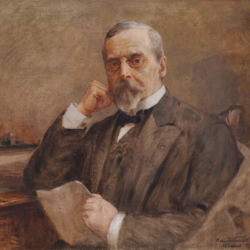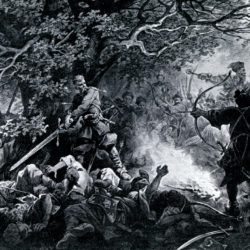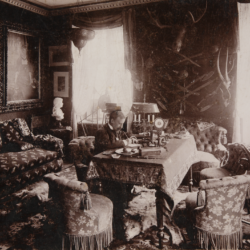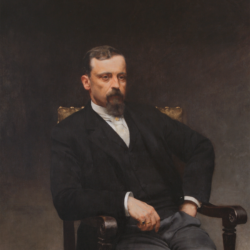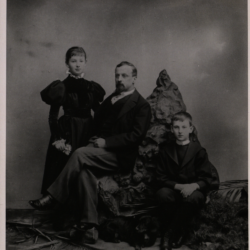
Living Pictures I
The peak of Sienkiewicz’s unquestioned and noncontroversial popularity witnessed the circulation of the author’s printed images, but also the proliferation of tableaux vivants. Printed press sources provide numerous examples of live performances, which were often combined with firework shows. In 1901, the Kurier Stanisławowski weekly described one such tableau, entitled Apoteoza Henryka Sienkiewicza (The apotheosis of Henry Sienkiewicz), in the following manner:
Next to Henryk Sienkiewicz’s bust, above which a charming genius spread the laurel wreath, all major heroes of the Trilogy and Quo Vadis are gathered, while a crowd clad in traditional Polish costumes is paying tribute to the writer’s bust. The upper part of the image depicts a mighty personification of Poland in a victorious pose with her arms raised.
The image made a grand impression. A firework show was an additional delight for the spectators – they forced the performers to raise the curtain three times.[1]
An entire series of tableaux vivants was also presented in 1900 at the Wielki Theater in Warsaw during the famous Sienkiewicz jubilee, which lasted for several hours and constituted the main event in the series of celebrations devoted to the writer. After the play Zagłoba swatem (Zagłoba the matchmaker) had been staged, local painters presented their tributes: Miłosz Kotarbiński prepared Za chlebem (For money) – a spectacle devoted to Polish immigrants in America; Julian Maszyński adapted the short story entitled “Pójdźmy za Nim!” (We shall follow him). According to the accounts in the press, Maszyński “made the major events more picturesque, imbuing the novella with highly aesthetical aspects.”[2]Kazimierz Alchimowicz staged Pojedynek Wołodyjowskiego (Wołodyjowski’s duel), and Franciszek Żmurko – Pożar Rzymu (The Great Fire of Rome). A journalist later wrote that the writer’s apotheosis was finally visible: “Apollo celebrated the Poet’s glory, while sister muses surrounded the statue in picturesque groups. The audience gladly applauded all the tableaux.”[3]
Krzysztof Stępnik mentions examples of similar events held in Zakopane, Stanisławów, Warsaw, Skarżysko, and Inowrocław. At the same time, he emphasizes that Sienkiewicz was actively shaping his own fame. The writer undeniably understood the mechanisms of the capitalist market: he planned the publishing schedule of his magazine novels so that their finales were released at Christmas; he also planned the premieres of the bound versions of his novels for Christmas.[4] Visual representations, however, remained (at least partially) out of Sienkiewicz’s control. Similarly, the reprints, adaptations, makeovers, and the publishing of abridged versions of his literary works stayed outside of Sienkiewicz’s sphere of influence, especially if these processes took place abroad. The information gathered from his letters as well as the analysis offered by Lech Ludorowski[5] prove that Henryk Sienkiewicz arranged the organization of his anniversaries so that they did not coincide with the celebrations held to commemorate Adam Mickiewicz.
The scene described in the Kurier Stanisławowski is an example of a tableau vivant that is at the same time immobile and revealed with the rise of the curtain. It is supposed to be watched from one side only. To a certain extent, the actors involved resemble effigies. Nevertheless, this is a performance enmeshed in a particular spatial and temporal frame, and thus impossible to reproduce. It is supposed to be delightful, but the organizational supply of the performance hints at its limitations.[6] Maria Gerson-Dąbrowska notes:
As for the costumes used in tableaux vivants – they are much easier to prepare than costumes for theatrical performances. They do not require a perfect trim, they can quickly be corrected with the use of pins, and a particular character may be dressed from the visible side only. It is easiest to prepare costumes for allegories […]. They can be made from anything: bedclothes, rugs, curtains, scarves, furs, and pieces of gauze. The sole requirements are creativity and some manual dexterity.[7]
Przypisy
- K. Stępnik, op. cit., p. 16; trans. K. F.
- Trans. K. F.
- “Jubileusz H. Sienkiewicza” [The jubilee of H. Sienkiewicz], Kurier Poranny December 23, 1900, no. 354, pp. 7–9; trans. K. F.
- See the letter to Adam Dobrowolski, the editor of the Kurier Warszawski paper; H. Sienkiewicz, Listy [Letters], vol. 1, part. 1, p. 230.
- L. Ludorowski, op. cit.
- J. McKenzie, Perform or Else: From Discipline to Performance, Routledge, New York 2001, pp. 55-94.
- M. Gerson-Dąbrowska, Obrazy żywe [Living pictures], Warsaw 1920, p. 21; trans. K. F.

